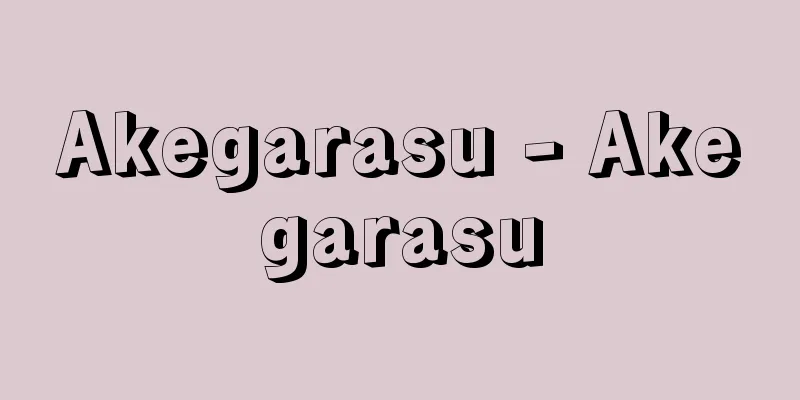Akegarasu - Akegarasu

|
[1] 〘 noun 〙① A crow that cries at dawn. Also, its sound. In the early modern period, it was used to express the emotion of a man and woman parting in the morning. ※Joruri, Omi Genji Senjinkan (1769), 9 "I now head into the castle, carrying another tatami mat, accompanied by the sound of the dawn crow, the crow."② A secret word for ink, or a secret word for a group of thieves. Crow. [Nihon Kyougoshu (1892)]③ A specialty confectionery of Odate , Akita Prefecture. Walnuts grown in the area are cut into small pieces, kneaded with amber sugar, and made into a paste about three centimeters in size. The cut surface of the walnuts looks like a crow flying in the sky at dawn, hence the name. [2][1] (akegarasu) A collection of haiku poems. One volume. One of Buson's Seven Collections. Published in 1773. Compiled by Takai Kito . A collection of hokku poems by Buson and his disciples. [2] The common name of a joruri piece about the double suicide of Miyoshino, a prostitute from Tsutaya in Shin- Yoshiwara, and Inosuke from Iseya in Asakusa Kuramae, in Mikawashima, Edo , in 1769 (Meiwa 6) during the Edo period. Due to the popularity of the Shinnai-bushi "Akegarasu Yume no Awayuki, " it was also composed in Kiyomoto, Tokiwazu, Gidayu, and other styles. The two actors' names were changed to Urazato and Tokijiro, so it is also called "Urasato Tokijiro." ① Shinnai-bushi. Words and music by Tsuruga Wakasa no Jo I. Original title: "Akegarasu Yume Awayuki." ② Kiyomoto-bushi. Words by Sakurada Jisuke III. Music by Kiyomoto Senzō. Original title: "Akegarasu Hana no Nureginu ." First performed in 1851 at Edo Ichimuraza. 3. Gidayubushi. Original title: "Akegarasu Yukinoakebono ". First performed in 1853 as a puppet show at Osaka Takemoto Tsunadayuza. 4. Rakugo. A humorous tale about a very strict young master, Tokijiro, who is tricked into going to Yoshiwara. Source: The Selected Edition of the Japanese Language Dictionary About the Selected Edition of the Japanese Language Dictionary Information |
|
[1] 〘名〙① 夜明けがたに鳴く烏。また、その声。近世、男女の朝の別れの情緒を表現するのに用いられた。※浄瑠璃・近江源氏先陣館(1769)九「我はこれより城内へとまたも畳を、明烏かはい、かはいの声につれ」② 墨をいう、てきや、盗人仲間の隠語。からす。〔日本隠語集(1892)〕③ 秋田県大館の名物菓子。同地方に産するクルミの実を小さく切って、琥珀糖(こはくとう)に練り合わせて、三センチメートルほどにした練り菓子。その切り口のクルミの実が、明け方の空を飛ぶ烏のように見えるというところからいう。[2][一] (あけ烏) 俳諧集。一巻。蕪村七部集の一つ。安永二年(一七七三)刊。高井几董(きとう)編。蕪村とその門下の発句を集めたもの。[二] 江戸時代、明和六年(一七六九)江戸三河島で新吉原蔦屋の遊女三吉野と浅草蔵前伊勢屋の伊之助が心中した事件をうたった浄瑠璃曲名の通称。新内節「明烏夢泡雪(あけがらすゆめのあわゆき)」の好評によって、清元、常磐津、義太夫などでも作曲された。二人の名を浦里と時次郎に変えたことから「浦里時次郎」とも呼ばれる。① 新内節。初世鶴賀若狭掾(わかさのじょう)作詞作曲。本名題「明烏夢泡雪」。② 清元節。三世桜田治助作詞。清元千蔵作曲。本名題「明烏花濡衣(あけがらすはなのぬれぎぬ)」。嘉永四年(一八五一)江戸市村座初演。③ 義太夫節。本名題「明烏六花(雪)曙(あけがらすゆきのあけぼの)」。嘉永六年(一八五三)大坂竹本綱太夫座の操り芝居で初演。④ 落語。堅物すぎる若旦那時次郎が、だまされて吉原に連れてゆかれたおかしみを演じる郭話(くるわばなし)。
出典 精選版 日本国語大辞典精選版 日本国語大辞典について 情報 |
Recommend
Leo (Leo)
The abbreviation is Leo. It is a major spring cons...
Chelate
Also called a chelate compound. A compound in whi...
Sol - zoru (English spelling) sol
A liquid in which fine particles of dispersoid (c...
Ansaldo [Company] (English spelling)
A leading Italian shipbuilding company. It was fou...
Icchu-bushi Uji school - Icchu-bushi Uji school
...The name of the head of the Icchu-bushi Uji sc...
Papyrus - Papyrus (English spelling)
A type of paper made from papyrus grass (scientif...
Horemhab
...However, the domestic turmoil caused by the ra...
Awashima faith - Awashima faith
This belief is related to the deity worshipped at...
Ruiju Myogisho - Ruiju Myogisho
An ancient Chinese character dictionary. It class...
Ant beetle (anthill beetle) - Ant beetle
A general term for insects belonging to the family...
Oldenburg
…After World War II, the region came under Britis...
Maritime Technology and Safety Bureau
The organization is made up of the Minister's...
Akamagaseki city
...Population: 259,795 (1995). Originally called ...
Computer Crime - Computer Hanzai
Computer crime : A crime related to computers. The...
Convex set
A set C in a vector space V with real coefficient...




![Onoe [town] - Onoe](/upload/images/67cb20d4f3597.webp)




